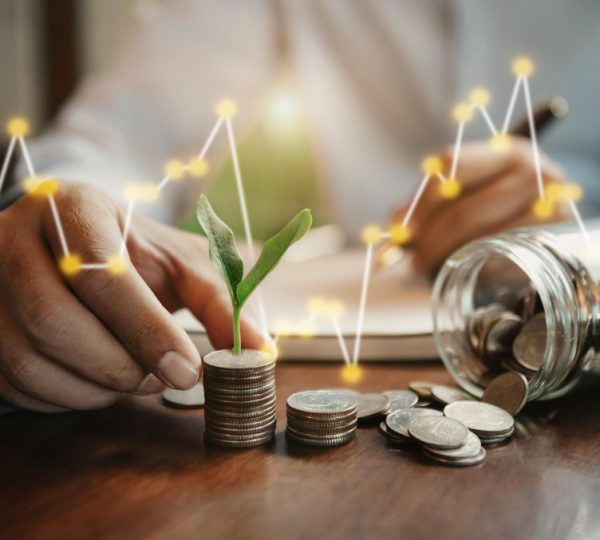Knowing Wealth: What Is It and How Is It Measured?
“Wealth: What Is It?
The value of all the valuable assets that a person, group of people, business, or nation has is measured as wealth. The entire market worth of all tangible and intangible assets is calculated, and all debts are subtracted. Wealth is the accumulation of limited resources. When some individuals, groups, or nations can amass many expensive items or help, they are considered affluent. In contrast to income, which may be seen in absolute or relative terms, wealth is a stock, whereas income is a flow.

Knowledge of Wealth
Different means of expressing wealth exist. All the tangible assets in one’s possession are what is meant by wealth in a purely physical sense. In terms of money, personal wealth is the most specific measure of wealth.
In many communities over time, wealth has been defined and measured differently. Cash is the most often used metric for assessing wealth in contemporary culture. Money serves as a unit of account in measuring wealth, for instance. However, it offers a simple common denominator for comparison. The amount to which outside factors may affect the value of money can significantly impact evaluating wealth in this way. Otherwise, it is possible to gauge and assess wealth using land and even cattle. For instance, the ancient Egyptians used wheat as a unit of measurement for prosperity. Sheep, horses, and cattle have frequently been employed as wealth indicators in herding societies.
Measurement of Wealth
The difficulty of assessing wealth in terms of various items is solved by evaluating wealth in terms of money. The values can then be combined for addition or subtraction. This thus makes it possible to use combined wealth as a handy indicator of wealth. Liabilities with fewer assets equal net value. Net worth is another name for shareholders’ equity or ledger value in the context of corporations. In plain English, net worth describes wealth as all assets within one’s control, except those that are ultimately someone else’s property. Unlike a flow variable like income, wealth is a stock variable.
Revenue measures the amount of cash (or products) earned over a certain period, whereas wealth reflects the quantity of valued economic items collected at a specific moment in time. Income is the accumulation of wealth through time (or subtraction, if it is negative).
Over time, a person with a positive net income will eventually become very wealthy. Although it is sometimes incorrectly referred to as a measure of wealth, a country’s gross domestic product (GDP) may be conceived of as a measure of income (a flow variable) (a stock variable). Being Wealthy can be defined as having a significant net worth; however, most people understand this concept in a more relative meaning. Total wealth can differ across people and groups depending on how it is assessed, whether in terms of money and net worth or commodities like wheat or sheep. We often use the relative disparities in wealth between individuals to categorize whether a person is affluent.
Research has repeatedly demonstrated that people’s perceptions of their own happiness and well-being are far more influenced by their assessments of income relative to others than by their absolute wealth. This is also a reason why of the idea of wealth is often exclusively used to limited economic items; plentiful and freely available things do not allow for any relative comparisons between persons.
One of the wealthiest American companies is the retailer Walmart, whose yearly sales exceed the GDP of numerous nations. Walmart is founded in Arkansas. It generated $559 billion in sales in 2021 and has operations in 24 different countries. Walmart, which will be ranked first on the Fortune 500 list in 2022, will run more than 10,500 shops worldwide and provide services to more than 220 million people each week.
Amazon, is the second-ranked company on Fortune’s list, with sales of $386 billion for 2021, which was equally impressive. The business continued to grow in 2021, recording earnings that were more than 54% greater than they were in 2020, despite going through a leadership transition and a labor scarcity. As of March 31, 2022, its market value of $1.66 trillion made it one of the wealthiest corporations in the world.
How does one get wealth?
One must set aside a percentage of their income for savings and investing over time to accumulate wealth.
How much money do the wealthiest 1% of people own?
As of June 29, 2022, the wealthiest 1% of wage earners own 31.9% of the country’s wealth.
Wealth management: What is it?
Financial, investment, and consulting services offered to customers with high net worth are referred to as wealth management.
Generational wealth: What is it?
Assets carried down through subsequent family generations are referred to as generational wealth.
The Great Gatsby Curve: What is it?
The link between economic disparity in a nation and the likelihood that its population would experience upward mobility is depicted by The Great Gatsby Curve. Inequality and a lack of upward mobility from one generation to the next are shown in graphs as having a significant positive association.
the conclusion
Wealth is a relative notion that mostly depends on one’s perspective and standard of worth. Most people assess things in terms of money, and those who have a lot of it are considered affluent. There are several methods for accumulating wealth, but there are better methods than one method. Wealth typically provides access and possibilities that would otherwise be unavailable without it, notwithstanding variances in how it is displayed. Economic Impacts of Exports and Imports
Consumers are used to finding things from all around the place at their local grocery shops and other establishments in the current global economy. Consumers have additional options thanks to these imports from other countries. Imports also assist customers in managing their tight family budgets because they are often made more inexpensively than any domestically produced counterpart.
When a country buys more than its exports, that are items shipped from one country to another, the trade balance will be skewed, and the currency would weaken. Since this value of money is one of the primary determinants of an economy’s prosperity and the gross domestic product, it could have a big impact on how people live their daily lives (GDP).Imports and exports must be kept in a good mix within a country. The GDP, exchange rate, rate of inflation, and borrowing costs of a nation may all be influenced by its import and export operations.
Gross Domestic Product Impact
A nation’s economic activity is broadly measured by its gross domestic product (GDP). Exports and imports significantly affect the expenditure approach of computing GDP. The GDP calculation is done as follows:
GDP=C+I+G+(X−M) \swhere:
C- Consumption of products and services by consumers
I-Investment spending on equipment for businesses
G – Government expenditures on public goods and services.
X – Exports
M – Imports
Imports are subtracted from exports to get net exports (X – M). When exports exceed imports, the net exports figure is positive. This shows the existence of a trade surplus in that nation. When exports are less than imports, the net exports figure is negative. This implies that the nation has a trade imbalance. A trade surplus promotes a nation’s economic expansion. A country’s factories and industrial facilities need a greater staff to maintain their high production levels, which are shown by higher exports.
A company’s strong export volume also converts into a financial inflow into the country, which promotes consumer spending and promotes economic growth.
Your Relationship With Imports And Exports
A nation must spend its own money while importing goods. The importers are regional companies that pay the exporters; the exporters are international organizations. High import levels are a sign of both a rising economy and robust domestic demand. If the majority of these imports are productive capital like machinery and equipment, the nation will benefit even more since over time, these assets will increase the productivity of the economy.An expanding trade balance between imports and exports is indicative of a healthy economy. This frequently indicates rapid economic development and a persistent excess or shortfall in global trade. When exports are rising and imports are significantly down, foreign countries may be performing better than the US economy.
In contrary, if export fall but imports rise, this may indicate that the domestic market is performing better than the global market.
For instance, the trade deficit between the United States and other countries usually worsens during times of high economic boom. Currently, the United States imports more things than it exports.
The U.S. continues to have one of the most productive economies in the world despite its persistent trade imbalance. Nevertheless, generally, a rise in imports and a growing trade deficit can have a negative influence on an expected exchange ratio, or the rate at which foreign currencies value its local currency.
Exchange rate effects
Because there is a continuous feedback loop between international commerce and how a nation’s currency is valued, the link between a nation’s imports and exports and its currency value is intricate. The trade surplus or deficit impacts the exchange rate, affecting the exchange rate. However, in general, a weaker home currency encourages exports and raises the price of imports. Vital native cash, on the other hand, makes imports more affordable and hinders exports. Consider an electrical component that will be sold to India and costs $10 in the United States.
Assume there is a 50 to 1 rupee to dollar exchange rate. The $10 component would price the Indian importer 500 rupees, excluding shipping and processing fees like import taxes.
The price of the component would rise to 550 rupees ($10 x 55) for the Indian buyer if the dollar were to appreciate to a level of 55 rupees (to one U.S. dollar) and the U.S. exporter did not raise the price of the component. This may compel the Indian importer to hunt for less expensive members from other countries. Thus, the dollar’s 10% increase against the rupee has made it more difficult for American exporters to compete in the Indian market. Meanwhile, assuming a conversion rate of 50 rupees to one dollar, consider an Indian clothing exporter whose primary market is the United States. When the export revenues are collected, the exporter will receive 500 rupees for each shirt they sell for $10 on the American market (neglecting shipping and other costs).
The exporter may sell the garment for $9.09 to get the same number of rupees if the currency drops from 55 rupees to a dollar (500). Therefore, the rupee’s 10% decline against the dollar has increased the Indian exporter’s competitiveness in the American market. The 10% increase in the dollar value relative to the rupee has made American exports of electrical parts uncompetitive. Still, it has also reduced the price of imported Indian shirts for Americans. On the other hand, a 10% depreciation in the rupee value has increased the competitiveness of Indian textile exports while increasing the cost of electronic component imports for Indian consumers.
The imports and exports of a nation can be significantly impacted by currency changes when millions of transactions compound this situation.
Effects on Interest Rates and Inflation
Imports and exports generally primarily impacted by inflation and interest rates through currency exchange rates. Typically, higher interest rates follow increasing inflation. It’s not obvious if this makes the currency stronger or weaker. According to conventional currency theory, a coin will lose value compared to other money if its inflation and interest rates are higher. The open interest rate parity theory holds that the disparity in speeds between the two countries equals the projected change in their exchange rates.
Thus, if the interest rates of two countries differ by 2%, the currency of the country with the higher interest rate should devalue by 2% relative to the country with the lower interest rate.
However, since the global credit crisis of 2008–2009, low-interest rates have mostly prevailed, leading investors and speculators to seek out the greater returns of currencies with higher rates. As a result, interest rates have gone up and currencies have strengthened. Naturally, this strategy is frequently restricted to nations with good economic foundations and stable currencies. These investors must be confident that currency depreciation would not negate greater returns.
Exports and the trade balance may suffer due to a more substantial home currency. By directly increasing the cost of resources like labor and materials, an increase in inflation can also have an impact on exports. The competitiveness of export prices in international trade is impacted by these more considerable costs.
Financial Reports
The best data to monitor imports and exports comes from a country’s merchandise balance of trade report. This report is released each month by the most of the main countries. The U.S. Census Bureau and Statistics Canada typically release trade balance figures during the first ten days of the month with a one-month lag. These reports include facts on the top trading partners, the most extensive product categories for imports and exports, and historical patterns. They also feature a variety of information.



